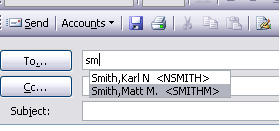
Removing invalid entries in your nickname cache
Exchange maintains a list of nicknames (historically referred to as the nickname cache) that is used to auto-complete e-mail addresses as you start to type an address in Outlook. Over time, the list of "shortcuts" of commonly used e-mails in your nickname cache will automatically grow; this can be a very useful tool. The downside to this feature, however, is that your nickname list will sometimes contain an old or invalid email address (e.g. for users who have changed their e-mail address or who have modified their account settings). When you use one of these outdated nicknames, your messages may fail to send, or they may not get to the desired recipient. To prevent this, follow these steps to remove the entry from your nickname cache.
- Open Outlook
- Create a new mail message
- Enter the first few characters of a person's name in the
TO:field. - Outlook will respond by showing you a list of user(s) in your nickname list that match the letters you just typed. To delete an entry from this list, use the arrow keys on your keyboard to highlight the user that you wish to remove from your cache. (In the example below, the entry "Smith, Matt M. ‹SMITHM›" has been selected.)

- With the entry highlighted, press the Delete key. This will remove the selected user's e-mail information from your nickname list. If you have a new e-mail address for this user, just type that user's new address in the
TO:field, or use the Outlook Address Book to pick the address.
Additional Notes
- When in doubt, you can view the e-mail address information for a user from Outlook by right-clicking on a resolved e-mail address (noted by an underline in Outlook) and choose "Outlook Properties". If the information is originating from a user on Exchange, the e-mail information will appear on the e-mail tab, otherwise the e-mail information for the user is presented on the properties window.

